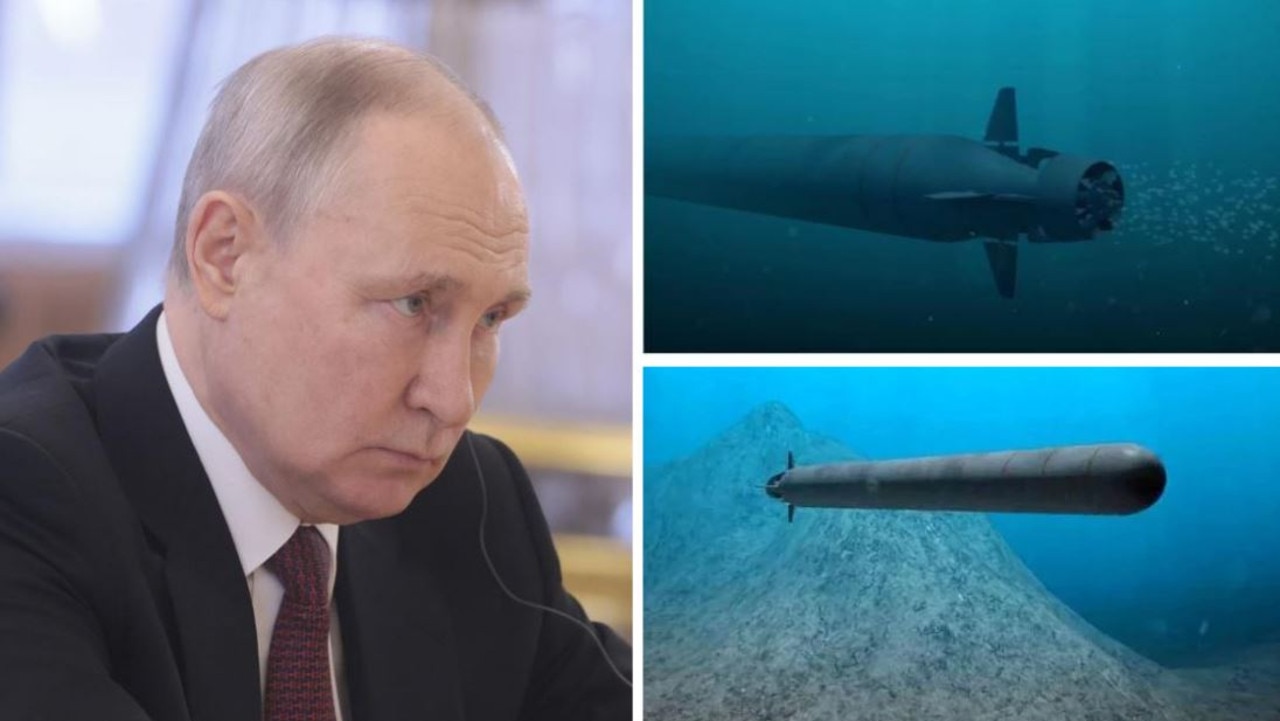It sounds like a Bond movie plot device: a nuclear-tipped torpedo is on its way to destroy New York City with a radioactive tsunami.
Now, the Bulletin of the Atomic Scientists (BOAS) – the group behind the infamous Doomsday Clock – warns that Russia’s rogue President Vladimir Putin wants 30 of them.
And while the concept sounds far-fetched, some military analysts believe the idea has potential.
Conventional intercontinental ballistic missiles (ICBMs) can be tracked from the moment they are launched. And many nations have demonstrated the ability to intercept their deadly warheads on the edge of space – well before they begin their apocalyptic plunge towards their targets.
Submarines, however, are built to be quiet and unseen. And Russia has already modified or built several vessels capable of carrying the enormous weapon President Putin dubbed “Poseidon” when he listed it among six new “Super Weapons” in 2019.
Once launched, unconfirmed Russian media reports claim its compact nuclear reactor can drive it at 185km/h over a distance of 10,000km at depths of up to 1000m.
The chance of detecting, identifying, tracking and intercepting such a weapon with current technology is untested.
“While some reports claim that Russia’s Poseidon may exist only as a propaganda scheme, experts generally agree that the system is ‘very real’ and has received significant resources from the Russian armed forces,” Dr Silky Kaur writes for BOAS.
Russian government-run news agency TASS claims the first batch of prototype Poseidon underwater drones was delivered earlier this year.
The first operational models are said to have a delivery date of 2027. TASS says 30 weapons will be deployed from four specially-equipped submarines.
Nuclear ‘disrupter’
A nuclear-tipped torpedo came within moments of being fired during the 1962 Cuban missile crisis.
While the normal-sized torpedo only carried a relatively small warhead, its use could have turned the Cold War hot.
A Soviet submarine’s commander was convinced war had already begun. So, when he spotted a US target, he ordered the warhead be made ready.
“It is only because the submarine’s deputy commander, Vasili Arkhipov, convinced other top officers that launching the torpedo would be a fatal mistake that a potential nuclear catastrophe was prevented,” writes Dr Kaur.
The Poseidon, however, is an autonomous drone.
There are no procedural checks and balances. There is no “human in the loop”.
Artificial intelligence will do what it is told to do. Or what it believes it has been told.
“These forms of guidance may lead to problems that include hacking by third parties, loss of control because of technical malfunctions, and environmentally-caused accidents that may lead to wrong signalling and thus inadvertent escalation,” Dr Kaur warns.
It’s just one new unknown created by the rush to integrate AI into modern war-fighting systems.
Many surveillance drones are already AI-controlled. And AI plays a significant role in the split-second decision-making of many defensive systems.
But giving machine intelligence the power of life or death remains controversial.
“It effectively transforms AI into an active participant during times of strategic adversity,” warns Dr Kaur.
“This has sparked a heated debate on whether these systems should be fully automated or not, as automation brings significant risks of misjudging the intentions of an opponent.”
Doomsday device
“It is widely speculated that the Poseidon may have been developed as a reaction to advances in US ballistic missile defence capabilities,” says Dr Kaur.
This project began with the infamous “Star Wars” project initiated by President Ronald Reagan.
The first successful shoot-down of an ICBM was in September 1984. Since then, several nations – including China and India – have tested similar capabilities.
But an underwater intercontinental weapon could once again tilt the odds back towards nuclear first strike weapons.
“Intelligence reports have suggested that Poseidon has undergone many trials, evidenced by the fact that some submarines have been modified and some are being specially built to accommodate the larger and heavier Poseidon,” says Dr Kaur.
Two of these submarines put to sea last month. And a recent scan of satellite imagery reveals new defences have been put in place about their Arctic Circle base.
But not everybody is convinced that Poseidon is a game changer.
Russia already has enough ICBMs, nuclear-capable intermediate-range missiles and cruise missiles to overwhelm the defences of Europe and the United States. And China is rapidly expanding its own ICBM force.
“Instead, many see Poseidon primarily as a psychological weapon intended for nuclear signalling rather than for its actual use,” says Dr Kaur.
“Some even speculate that the Poseidon will remain at the prototype stage and serve mainly political objectives, such as renewed talks with the United States on ballistic missile defence systems.
“The weapon’s primary intent may be in the uncertainty, speculation and fear it can provoke.”
Jamie Seidel is a freelance writer | @JamieSeidel

